Weekly Tax Brief
Teachers and others can deduct eligible educator expenses this year — and more next year and beyond
- Details
- Published: 05 September 2025 05 September 2025

At back-to-school time, much of the focus is on the students returning to the classroom — and on their parents buying them school supplies, backpacks, clothes, etc., for the new school year. But teachers are also buying school supplies for their classrooms. And in many cases, they don’t receive reimbursement. Fortunately, they may be able to deduct some of these expenses on their tax returns. And, beginning next year, eligible educators will have an additional deduction opportunity under the One Big Beautiful Bill Act (OBBBA).
The current above-the-line deduction
Eligible educators can deduct some of their unreimbursed out-of-pocket classroom costs under the educator expense deduction. This is an “above-the-line” deduction, which means you don’t have to itemize and it reduces your adjusted gross income (AGI), which has an added benefit: Because AGI-based limits affect a variety of tax breaks, lowering your AGI might help you maximize your tax breaks overall.
To be eligible, taxpayers must be kindergarten through grade 12 teachers, instructors, counselors, principals or aides. Also, they must work at least 900 hours a school year in a school that provides elementary or secondary education as determined under state law.
For 2025, up to $300 of qualified expenses paid during the year that weren’t reimbursed can be deducted. (The deduction limit is $600 if both taxpayers are eligible educators who file a joint tax return, but these taxpayers can’t deduct more than $300 each.) The limit is annually indexed for inflation but typically doesn’t go up every year.
Examples of qualified expenses include books, classroom supplies, computer equipment (including software), other materials used in the classroom, and professional development courses. For courses in health and physical education, the costs for supplies are qualified expenses only if related to athletics.
A new miscellaneous itemized deduction
The OBBBA makes permanent the Tax Cut and Jobs Act’s (TCJA’s) suspension of miscellaneous itemized deductions subject to the 2% of AGI floor. This had included unreimbursed employee business expenses such as teachers’ out-of-pocket classroom expenses. The suspension had been in place since 2018.
But the OBBBA creates a new miscellaneous itemized deduction for educator expenses. This is in addition to the $300 above-the-line deduction. And this deduction isn’t subject to the 2% of AGI floor or a specific dollar limit. The new deduction is available for eligible expenses incurred after Dec. 31, 2025.
Both who’s eligible and what expenses qualify are a little broader for the itemized deduction than for the above-the-line deduction. For example, interscholastic sports administrators and coaches are also eligible. And, for courses in health and physical education, the supplies don’t have to be related to athletics.
Keep in mind that you’ll have to itemize deductions to claim this new deduction next year. Taxpayers can choose to itemize this and certain other deductions or to take the standard deduction based on their filing status. Itemizing deductions saves tax only when the total is greater than the standard deduction. The OBBBA has made permanent the nearly doubled standard deductions under the TCJA, so fewer taxpayers are benefiting from itemizing.
Carefully track expenses
If you’re a teacher or other educator, keep receipts when you pay for eligible expenses and note the date, amount and purpose of each purchase. Have questions about educator deductions or other tax-saving strategies? Please contact us.
© 2025
New rules could boost your R&E tax savings in 2025
- Details
- Published: 02 September 2025 02 September 2025

A major tax change is here for businesses with research and experimental (R&E) expenses. On July 4, 2025, the One Big Beautiful Bill Act (OBBBA) reinstated the immediate deduction for U.S.-based R&E expenses, reversing rules under the Tax Cuts and Jobs Act (TCJA) that required businesses to capitalize and amortize these costs over five years (15 years for research performed outside the United States).
Making the most of R&E tax-saving opportunities
The immediate domestic R&E expense deduction generally is available beginning with eligible 2025 expenses. It can substantially reduce your taxable income, but there are strategies you can employ to make the most of R&E tax-saving opportunities:
Apply the changes retroactively. If you qualify as a small business (average annual gross receipts of $31 million or less for the last three years), you can file amended returns for 2022, 2023 and/or 2024 to claim the immediate R&E expense deduction and potentially receive a tax refund for those years. The amended returns must be filed by July 4, 2026.
Accelerate remaining deductions. Whatever the size of your business, if you began to amortize and capitalize R&E expenses in 2022, 2023 and/or 2024, you can deduct the remaining amount either on your 2025 return or split between your 2025 and 2026 returns, rather than continuing to amortize and capitalize over what remains of the five-year period.
Relocate research activities. Consider relocating foreign research activities to the United States. Before the OBBBA, the five-year vs. 15-year amortization period made domestic R&E activities more attractive from a tax perspective. Now the difference between a current deduction and 15-year amortization makes domestic R&E activities even more advantageous tax-wise.
Take advantage of the research credit. A tax deduction reduces the amount of income that’s taxed, while a tax credit reduces the actual tax you owe dollar-for-dollar, providing much more tax savings than a deduction of an equal amount. So consider whether you may be eligible for the tax credit for “increasing research activities.” But keep in mind that the types of expenses that qualify for the credit are narrower than those that qualify for the deduction. And you can’t claim both the credit and the deduction for the same expense.
We’re here to help
With the recent changes to the R&E expense rules, understanding your options is more important than ever. Our team can walk you through the updates, evaluate potential strategies, and help you determine the best approach to maximize your savings and support your business goals.
© 2025
Investing in qualified small business stock now offers expanded tax benefits
- Details
- Published: 28 August 2025 28 August 2025

By purchasing stock in certain small businesses, you can diversify your investment portfolio. You also may enjoy preferential tax treatment, some of which is getting even better under the One Big Beautiful Bill Act (OBBBA) that was signed into law in July: Qualified small business (QSB) stock now offers more tax-saving opportunities.
QSB defined
A QSB generally is a U.S. C corporation that meets two requirements, one of which has been eased by the OBBBA to allow more businesses to qualify:
1. It must be engaged in an active trade or business. A qualified active business is generally any trade or business other than:
- Service businesses in the following fields: health, law, engineering, architecture, accounting, actuarial science, performing arts, consulting, athletics, financial services and brokerage services,
- Banking, insurance, financing, leasing, investing and similar businesses,
- Farming businesses,
- Certain oil, gas and mining businesses, and
- Operators of hotels, motels, restaurants and similar businesses.
Additionally, the company must use at least 80% of its assets (by value) to conduct one or more qualified active businesses. And no more than 10% of its assets can consist of nonbusiness real estate.
2. It must have assets below a certain ceiling. Before the OBBBA, the business’s aggregate gross assets generally couldn’t exceed $50 million. The OBBBA increases the asset ceiling to $75 million (adjusted for inflation after 2026) for stock issued after July 4, 2025.
If the issuer owns more than 50% of another corporation’s stock, the subsidiary’s assets are included for purposes of the gross asset test. A corporation isn’t disqualified if its assets grow beyond the threshold after issuing the stock.
A valuable gain exclusion
When QSB stock tax breaks were initially introduced, you could exclude 50% of your capital gain from the sale of QSB stock if you’d held it at least five years. Subsequently, Congress enhanced the exclusion. If you acquired QSB stock after February 17, 2009, and before September 28, 2010, 75% of the gain is excludible after the five-year holding period. If you acquired it on or after September 28, 2010, the exclusion is 100% after five years.
Now the OBBBA provides new, but smaller exclusions for QSB stock held for shorter periods. Specifically, it provides a 75% exclusion for QSB stock held for four years and a 50% exclusion for QSB stock held for three years. These exclusions go into effect for QSB stock acquired after July 4, 2025.
If the QSB stock is received by gift or inheritance, the transferor’s holding period is added to the recipient’s.
Additional rules
To qualify for the gain exclusion, generally you must acquire the stock as part of an original issuance. In other words, you must acquire it directly from the corporation (or through an underwriter) — not from an existing shareholder — in exchange for money or property (other than stock) or as compensation for services. This requirement has some exceptions, including for stock received by gift or inheritance.
There is also a limit on the size of the exclusion. The amount of QSB gain on a particular issuer’s stock that you may exclude each year is limited to the greater of $10 million or 10 times your aggregate adjusted tax basis in stock sold during the tax year.
Finally, be aware that some states don’t offer QSB gain exclusions. So state-level taxes may still apply.
One more opportunity
If within 60 days of selling QSB stock you buy other QSB stock with the proceeds, you can defer any tax on your gain until you dispose of the new stock. The rolled-over gain reduces your basis in the new stock. For determining long-term capital gains treatment, the new stock’s holding period includes the holding period of the stock you sold.
Similar rules apply if QSB stock is converted into a different stock of the same corporation. The original stock’s holding period is added to the new stock’s holding period.
Consider carefully
QSB stock offers some significant tax benefits. But, as when contemplating any investment, you must think about more than just taxes. You should also consider factors such as your investment goals, time horizon and risk tolerance. Contact us to discuss the tax implications in more detail.
© 2025
Divorcing as a business owner? Don’t let taxes derail your settlement
- Details
- Published: 26 August 2025 26 August 2025

Divorce is stressful under any circumstances, but for business owners, the process can be even more complicated. Your business ownership interest is often one of your largest personal assets, and in many cases, part or all of it will be considered marital property. Understanding the tax rules that apply to asset division can help you avoid costly surprises.
Tax-free transfers
Most assets — including cash and business ownership interests — can be divided between spouses without triggering federal income or gift taxes. Under this tax-free transfer rule, the spouse receiving the asset assumes its existing tax basis (used to determine gain or loss) and holding period (short-term or long-term).
Example: If you give your spouse the marital home in exchange for keeping 100% of your company stock, the transfer is tax-free. Both the home and the stock retain their original tax basis and holding period for the new owner.
Tax-free treatment applies to transfers made:
- Before the divorce is finalized,
- At the time of divorce, and
- After divorce, if they occur within one year of the marriage ending or within six years if required under the divorce agreement.
Future tax consequences
While transfers may be tax-free at the time, the recipient will owe taxes if he or she later sells an appreciated asset (where fair market value exceeds the tax basis).
For instance, if your ex-spouse receives 48% of your highly appreciated company stock, no tax is due at transfer. However, when he or she sells the stock, your ex will pay any capital gains tax based on your original basis and holding period.
Important: Appreciated assets come with built-in tax liabilities, which generally makes them less valuable than an equal amount of cash or non-appreciated property. Always account for taxes when negotiating a divorce settlement.
This rule also applies to ordinary-income assets — such as business receivables, inventory or nonqualified stock options. These can be transferred tax-free, but the recipient will report the income and pay taxes when the asset is sold, collected or exercised.
Valuation and adjustments for tax liabilities
A critical step in a divorce involving a business is determining its value. When valuing a business interest for this purpose, the valuator must understand what’s appropriate under applicable state law and legal precedent because the rules and guidance may vary across jurisdictions. The valuation process may be contentious, especially if one spouse is actively involved in the business and the other isn’t (or will no longer be involved after the divorce is settled). A professional valuation considers tangible assets (including equipment, inventory and property), intangible assets (including intellectual property) and other factors.
Potential tax liabilities are also considered during the valuation process. Examples include deferred taxes on appreciated assets, liabilities from unreported income or cash distributions, and implications from goodwill. These adjustments can significantly affect the business interest’s value and the fairness of the settlement agreement.
Nontax issues
There are a number of issues unrelated to taxes that a divorcing business owner should be prepared to address, including:
- Cash flow and liquidity. Divorce settlements may require significant cash outlays — for example, to buy out a spouse’s share of the business or to meet alimony and child support obligations. This can strain the business’s liquidity, especially if the owner must take out loans or sell assets to meet these obligations. We can help assess the impact of these financial demands and develop strategies to maintain healthy cash flow, such as restructuring debt or revisiting budgets.
- Privacy and confidentiality. Divorce proceedings may expose sensitive business information. Financial statements, client lists and proprietary data may become part of the public record. Business owners should work with legal and financial advisors to protect confidentiality, possibly through protective orders or sealed filings.
Plan ahead to minimize risk
Divorce can create unexpected tax and financial consequences, especially when dividing business interests and retirement accounts (such as 401(k) accounts and IRAs). The financial stakes are often higher for business owners, making careful planning essential.
We can help you navigate these rules and structure your settlement to minimize tax liabilities while complying with state community property laws. The earlier you address potential tax issues, the better your financial outcome after divorce.
© 2025
A tax guide to choosing the right business entity
- Details
- Published: 19 August 2025 19 August 2025
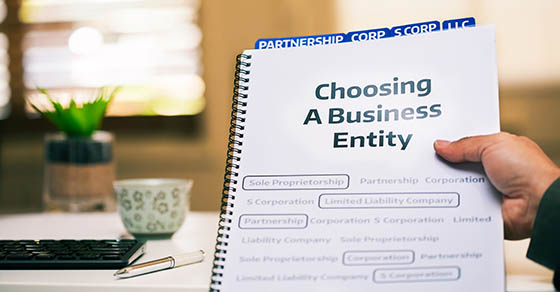
One of the most critical decisions entrepreneurs make when starting or restructuring a business is choosing the right entity type. This choice directly impacts how the business is taxed, the level of administrative complexity and regulatory compliance obligations. While legal liability considerations also matter, we will focus on tax implications. For liability advice, consult a legal professional.
Whether launching a new venture or reassessing your current structure, understanding how each entity is taxed can help you make strategic and compliant decisions. Here’s a brief overview of five entities.
1. Sole proprietorship: Simple with full responsibility
A sole proprietorship is the easiest structure to set up. It’s owned and operated by one person and requires minimal administrative effort. Here are the main features:
- Taxation. Income and losses are reported on the owner’s personal tax return on Schedule C of Form 1040. Income is subject to 15.3% federal self-employment tax, and the business itself isn’t taxed separately. The owner may also qualify for a Qualified Business Income (QBI) deduction, potentially reducing the effective tax rate.
- Compliance. Aside from obtaining necessary licenses or a business name registration, there’s little required paperwork. However, the owner is personally liable for all business debts and legal obligations.
2. S Corporation: Pass-through entity with payroll considerations
An S corp is a tax designation offering pass-through taxation benefits while imposing stricter rules. Here are the highlights:
- Taxation. S corps don’t pay income tax at the entity level. Instead, profits or losses are passed through to shareholders via Schedule K-1 and reported on individual returns. A key tax benefit is that shareholders who are employees receive a salary (subject to payroll tax), while additional profit distributions aren’t subject to self-employment tax. However, the salary must be reasonable. The business is eligible for QBI deductions.
- Compliance. To qualify, S corps must have 100 or fewer shareholders, all U.S. citizens or residents, and only one class of stock. They must file Form 2553, issue annual Schedule K-1s and follow corporate formalities like shareholder meetings and recordkeeping. An informational return (Form 1120-S) is also required.
3. Partnership: Collaborative ownership with pass-through taxation
A partnership involves two or more individuals jointly operating a business. Common types include general partnerships, limited partnerships, and limited liability partnerships (LLPs). Here’s what makes it unique:
- Taxation. Partnerships are pass-through entities. The business files Form 1065 (an informational return), and income or loss is distributed to partners on Schedule K-1. Partners report this on their personal returns. General partners must pay self-employment tax, while limited partners usually don’t. The business is eligible for QBI deductions.
- Compliance. Partnerships require a detailed partnership agreement, coordinated recordkeeping and clear profit-sharing arrangements. While more complex than a sole proprietorship, partnerships offer flexibility for growing businesses.
4. Limited liability company: Flexible and customizable
An LLC merges elements of corporations and partnerships, offering owners — called members — both operational flexibility and liability protection.
- Taxation. By default, a single-member LLC is taxed like a sole proprietorship, and a multimember LLC like a partnership. However, LLCs may elect to be taxed as a C or S corp by filing Form 8832 or Form 2553. This gives owners control over their tax strategies. LLCs that don’t elect C corp status are eligible for QBI deductions.
- Compliance. LLCs require articles of organization and often must have an operating agreement. Though not as complex as corporations, they still generally face state-specific compliance requirements and annual filings.
5. C Corporation: Double taxation with scalability
A C corp is a distinct legal entity offering the most liability protection and growth potential through stock issuance. Here are its features:
- Taxation. C corps face double taxation — the business pays taxes on earnings (currently at a 21% federal rate), and shareholders pay taxes again on dividends. However, C corps can offer deductible benefits (for example, health insurance, retirement plans) and retain earnings without immediately distributing profits. C corps aren’t eligible for QBI deductions.
- Compliance: These entities require the most administrative upkeep, including bylaws, annual meetings, board minutes, and extensive state and federal reporting. C corps are ideal for companies seeking venture capital or IPOs.
After hiring employees
Regardless of entity type, adding employees increases compliance requirements. Businesses must obtain an Employer Identification Number (EIN) and withhold federal and state payroll taxes. Employers also take on added responsibilities related to benefits, tax deposits, and employment law compliance.
What’s right for you?
There’s no universal answer to which entity is best. The right choice depends on your growth goals, ownership structure and financial needs. Tax optimization is a critical factor. For example, an LLC electing S corp status may help minimize self-employment taxes if set up properly. Contact us. We can coordinate with your attorney to ensure your structure supports both your tax strategies and business goals.
© 2025
The next estimated tax payment deadline is coming up soon
- Details
- Published: 14 August 2025 14 August 2025

If you make quarterly estimated tax payments, the amount you owe may be affected by the One Big Beautiful Bill Act (OBBBA). The law, which was enacted on July 4, 2025, introduces new deductions, credits and tax provisions that could shift your income tax liability this year.
Tax basics
Federal estimated tax payments are designed to ensure that certain individuals pay their fair share of taxes throughout the year.
If you don’t have enough federal tax withheld from your paychecks and other payments, you may have to make estimated tax payments. This is the case if you receive interest, dividends, self-employment income, capital gains, a pension or other income that’s not covered by withholding.
Individuals generally must pay 25% of a “required annual payment” by April 15, June 15, September 15, and January 15 of the following year, to avoid an underpayment penalty. If one of those dates falls on a weekend or holiday, the payment is due on the next business day.
The third installment for 2025 is due on Monday, September 15. Payments are made using Form 1040-ES.
Amount to be paid
The required annual payment for most individuals is the lower of 90% of the tax shown on the current year’s return or 100% of the tax shown on the return for the previous year. However, if the adjusted gross income on your previous year’s return was more than $150,000 ($75,000 if you’re married filing separately), you must pay the lower of 90% of the tax shown on the current year’s return or 110% of the tax shown on the return for the previous year.
Most people who receive the bulk of their income in the form of wages satisfy these payment requirements through the tax withheld from their paychecks by their employers. Those who make estimated tax payments generally do so in four installments. After determining the required annual payment, divide that number by four and make four equal payments by the due dates.
But you may be able to use the annualized income method to make smaller payments. This method is useful to people whose income flow isn’t uniform over the year, perhaps because of a seasonal business. For example, if your income comes exclusively from a business operated in a resort area during June, July and August, no estimated payment is required before September 15.
The underpayment penalty
If you don’t make the required payments, you may be subject to an underpayment penalty. The penalty equals the product of the interest rate charged by the IRS on deficiencies times the amount of the underpayment for the period of the underpayment.
However, the underpayment penalty doesn’t apply to you if:
- The total tax shown on your return is less than $1,000 after subtracting withholding tax paid;
- You had no tax liability for the preceding year, you were a U.S. citizen or resident for that entire year, and that period was 12 months;
- For the fourth (January 15) installment, you file your return by that January 31 and pay your tax in full; or
- You’re a farmer or fisherman and pay your entire estimated tax by January 15 or pay your entire tax and file your tax return by March 2, 2026.
In addition, the IRS may waive the penalty if the failure was due to casualty, disaster or other unusual circumstances, and it would be inequitable to impose the penalty. The penalty can also be waived for reasonable cause during the first two years after you retire (and reach age 62) or become disabled.
OBBBA highlights
Several provisions of the OBBBA could directly affect quarterly estimated tax payments because they change how much tax some individuals will ultimately owe for the year. For example, the law introduces a temporary (2025 through 2028) additional $6,000 deduction for seniors, which can lower taxable income. It creates new deductions for overtime pay, tips and auto loan interest — available even if you don’t itemize — which can meaningfully reduce estimated liabilities. The bill also increases the state and local tax deduction cap for certain taxpayers and temporarily enhances the Child Tax Credit. Because these deductions and credits apply during the tax year rather than after, they can reduce your quarterly payment obligations mid-year, making it important to recalculate estimates to avoid overpayment or underpayment penalties.
Seek guidance now
Contact us if you need help figuring out your estimated tax payments or have other questions about how the rules apply to you.
© 2025
A tax guide to choosing the right business entity
- Details
- Published: 12 August 2025 12 August 2025
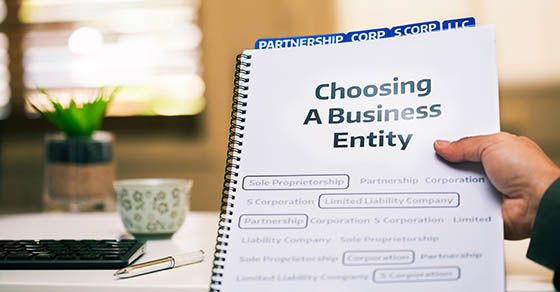
One of the most critical decisions entrepreneurs make when starting or restructuring a business is choosing the right entity type. This choice directly impacts how the business is taxed, the level of administrative complexity and regulatory compliance obligations. While legal liability considerations also matter, we will focus on tax implications. For liability advice, consult a legal professional.
Whether launching a new venture or reassessing your current structure, understanding how each entity is taxed can help you make strategic and compliant decisions. Here’s a brief overview of five entities.
1. Sole proprietorship: Simple with full responsibility
A sole proprietorship is the easiest structure to set up. It’s owned and operated by one person and requires minimal administrative effort. Here are the main features:
- Taxation. Income and losses are reported on the owner’s personal tax return on Schedule C of Form 1040. Income is subject to 15.3% federal self-employment tax, and the business itself isn’t taxed separately. The owner may also qualify for a Qualified Business Income (QBI) deduction, potentially reducing the effective tax rate.
- Compliance. Aside from obtaining necessary licenses or a business name registration, there’s little required paperwork. However, the owner is personally liable for all business debts and legal obligations.
2. S Corporation: Pass-through entity with payroll considerations
An S corp is a tax designation offering pass-through taxation benefits while imposing stricter rules. Here are the highlights:
- Taxation. S corps don’t pay income tax at the entity level. Instead, profits or losses are passed through to shareholders via Schedule K-1 and reported on individual returns. A key tax benefit is that shareholders who are employees receive a salary (subject to payroll tax), while additional profit distributions aren’t subject to self-employment tax. However, the salary must be reasonable. The business is eligible for QBI deductions.
- Compliance. To qualify, S corps must have 100 or fewer shareholders, all U.S. citizens or residents, and only one class of stock. They must file Form 2553, issue annual Schedule K-1s and follow corporate formalities like shareholder meetings and recordkeeping. An informational return (Form 1120-S) is also required.
3. Partnership: Collaborative ownership with pass-through taxation
A partnership involves two or more individuals jointly operating a business. Common types include general partnerships, limited partnerships, and limited liability partnerships (LLPs). Here’s what makes it unique:
- Taxation. Partnerships are pass-through entities. The business files Form 1065 (an informational return), and income or loss is distributed to partners on Schedule K-1. Partners report this on their personal returns. General partners must pay self-employment tax, while limited partners usually don’t. The business is eligible for QBI deductions.
- Compliance. Partnerships require a detailed partnership agreement, coordinated recordkeeping and clear profit-sharing arrangements. While more complex than a sole proprietorship, partnerships offer flexibility for growing businesses.
4. Limited liability company: Flexible and customizable
An LLC merges elements of corporations and partnerships, offering owners — called members — both operational flexibility and liability protection.
- Taxation. By default, a single-member LLC is taxed like a sole proprietorship, and a multimember LLC like a partnership. However, LLCs may elect to be taxed as a C or S corp by filing Form 8832 or Form 2553. This gives owners control over their tax strategies. LLCs that don’t elect C corp status are eligible for QBI deductions.
- Compliance. LLCs require articles of organization and often must have an operating agreement. Though not as complex as corporations, they still generally face state-specific compliance requirements and annual filings.
5. C Corporation: Double taxation with scalability
A C corp is a distinct legal entity offering the most liability protection and growth potential through stock issuance. Here are its features:
- Taxation. C corps face double taxation — the business pays taxes on earnings (currently at a 21% federal rate), and shareholders pay taxes again on dividends. However, C corps can offer deductible benefits (for example, health insurance, retirement plans) and retain earnings without immediately distributing profits. C corps aren’t eligible for QBI deductions.
- Compliance: These entities require the most administrative upkeep, including bylaws, annual meetings, board minutes, and extensive state and federal reporting. C corps are ideal for companies seeking venture capital or IPOs.
After hiring employees
Regardless of entity type, adding employees increases compliance requirements. Businesses must obtain an Employer Identification Number (EIN) and withhold federal and state payroll taxes. Employers also take on added responsibilities related to benefits, tax deposits, and employment law compliance.
What’s right for you?
There’s no universal answer to which entity is best. The right choice depends on your growth goals, ownership structure and financial needs. Tax optimization is a critical factor. For example, an LLC electing S corp status may help minimize self-employment taxes if set up properly. Contact us. We can coordinate with your attorney to ensure your structure supports both your tax strategies and business goals.
© 2025
The new law includes a game-changer for business payment reporting
- Details
- Published: 04 August 2025 04 August 2025
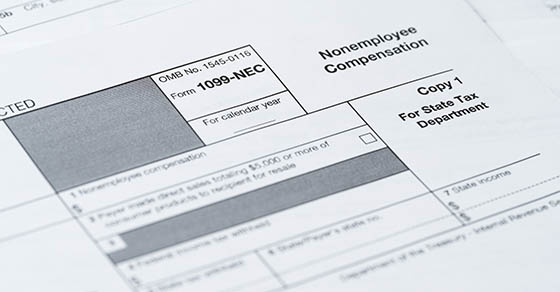
The One, Big Beautiful Bill Act (OBBBA) contains a major overhaul to an outdated IRS requirement. Beginning with payments made in 2026, the new law raises the threshold for information reporting on certain business payments from $600 to $2,000. Beginning in 2027, the threshold amount will be adjusted for inflation.
The current requirement: $600 threshold
For decades, the IRS has required that businesses file Form 1099-NEC (previously 1099-MISC) for payments made to independent contractors that exceed $600 in a calendar year. This threshold amount has remained unchanged since the 1950s!
The same $600 threshold is in place for Forms 1099-MISC, which businesses file for several types of payments, including prizes, rents and payments to attorneys.
Certain deadlines must be met. A Form 1099-NEC must be filed with the IRS by January 31 of the year following the year in which a payment was made. A copy must be sent to the recipient by the same January 31 deadline.
A Form 1099-MISC must also be provided to a recipient by January 31 of the year following a payment, but unlike Form 1099-NEC, the 1099-MISC deadline for the IRS depends on how it’s submitted. If a business is filing the form on paper, the deadline is February 28. If the form is being submitted electronically, the deadline is March 31.
The new rules raise the bar to $2,000
Under the OBBBA, the threshold increases to $2,000, meaning:
- Fewer 1099s will need to be issued and filed.
- There will be reduced paperwork and administrative overhead for small businesses.
- There will be better alignment with inflation and modern economic realities.
For example, let’s say your business engaged a freelance graphic designer and pays the individual $650 this year. You’ll need to send a 1099-NEC to the designer for calendar year 2025. But if you hire the same individual in 2026, you won’t be required to send a 1099 to the graphic designer or the IRS in 2027 unless the designer earns more than $2,000.
The money is still taxable income
Even if an independent contractor doesn’t receive a 1099-NEC because the amount paid was below the threshold amount, the payment(s) are still considered part of the individual’s gross income. The contractor must report all business income received on his or her tax return, unless an exclusion applies.
In addition, businesses must continue to maintain accurate records of all payments.
There are changes to Form 1099-K, too
The OBBBA also reinstates a higher threshold for Forms 1099-K, used by third-party payment processors. The reporting threshold returns to $20,000 and 200 transactions, rolling back the phased-in lower thresholds that had dropped toward $600 by 2026. This rollback undoes changes from the 2021 American Rescue Plan Act and earlier IRS delay plans.
Simplicity and relief
Raising the threshold will ease the filing burden for millions of businesses, especially small operations that rely on contractors. There will also be less risk that an IRS penalty will be imposed for failing to file a Form 1099 when required. Contact us with any questions about the new rules or your filing requirements.
© 2025
What you still need to know about the alternative minimum tax after the new law
- Details
- Published: 31 July 2025 31 July 2025
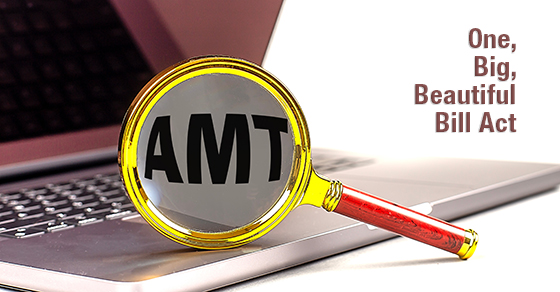
The alternative minimum tax (AMT) is a separate federal income tax system that bears some resemblance to the regular federal income tax system. The difference is that the individual AMT system taxes certain types of income that are tax-free under the regular system. It also disallows some deductions that are allowed under the regular system. If the AMT exceeds your regular tax bill, you owe the larger AMT amount.
Tax law changes
The Tax Cuts and Jobs Act (TCJA) made the individual alternative minimum tax (AMT) rules more taxpayer-friendly for 2018-2025 and significantly reduced the odds that you’ll owe the AMT for those years. But the new One Big Beautiful Bill Act (OBBBA) contains mixed news about your AMT exposure.
AMT rates
The maximum AMT rate is “only” 28% versus the 37% maximum regular federal income tax rate. At first glance, it may seem counterintuitive that anyone would worry about paying AMT. However, while the top AMT rate is lower, it applies to a much larger taxable base with fewer deductions and credits. That’s why people in certain situations still need to worry about it.
For 2025, the maximum 28% AMT rate kicks in when your taxable income, calculated under the AMT rules, exceeds an inflation-adjusted threshold of $239,100 for married joint-filing couples or $119,550 for other taxpayers. Below these thresholds, the AMT rate is 26%.
AMT exemptions
Under the AMT rules, you’re allowed an inflation-adjusted AMT exemption — effectively a deduction — in calculating your alternative minimum taxable income. The TCJA significantly increased the exemption amounts for 2018-2025. The OBBBA made the TCJA increased exemption amounts permanent, with annual inflation adjustments.
For 2025, the exemption amounts are $88,100 for unmarried individuals, $137,000 married joint-filing couples, and $68,500 for married individuals who file separate returns.
Exemption phase-out rule
At high levels of alternative minimum taxable income, your AMT exemption is phased out, which increases the odds that you’ll owe the tax. The TCJA dramatically increased the phase-out thresholds to levels where most taxpayers are unaffected by the phase-out rule. For 2025, the exemption begins to be phased out when alternative minimum taxable income exceeds $626,350 or $1,252,700 for a married joint-filing couple. For 2018-2025, the applicable exemption is reduced by 25% of the excess of your alternative minimum taxable income over the applicable phase-out threshold.
Mixed news in the OBBBA
Starting in 2026, the OBBBA makes the $500,000 and $1 million exemption phase-out threshold permanent. That’s the good news.
The bad news: Starting in 2026, the new law resets the exemption phase-out thresholds to $500,000 and $1 million with annual inflation adjustments for 2026 and beyond. So for 2026, these phase-out thresholds will be lower than the higher thresholds that apply for 2025. More bad news: Starting in 2026, the OBBBA increases the exemption phase-out percentage from 25% to 50%.
Bottom line: For 2026 and beyond, AMT exemptions for higher-income taxpayers can be phased out faster. That means more taxpayers may owe the AMT for 2026 and beyond.
AMT risk factors
Various interacting factors make it difficult to pinpoint exactly who’ll be hit by the AMT and who’ll dodge it. Here are five implications and risk factors.
- Substantial income from capital gains or other sources. When you have high income, from whatever sources, it can cause your AMT exemption to be partially or completely phased out. That increases the odds that you’ll owe the AMT.
- Itemized state and local tax (SALT) deductions. You can’t deduct SALT expenses under the AMT rules. This can hurt those living in high-tax states.
- Exercise of incentive stock options (ISOs). When you exercise an ISO, the bargain element (the difference between the market value of the shares on the exercise date and your ISO exercise price) doesn’t count as income under the regular tax rules, but it counts as income under the AMT rules.
- Standard deductions. Standard deductions are disallowed under the AMT rules.
- Private activity bond interest income. This category of interest income is tax-free for regular tax purposes but taxable under the AMT rules.
Determine your status
The TCJA significantly reduced the odds that you’ll owe the AMT. But the OBBBA increases the odds for some taxpayers, thanks to unfavorable changes to the AMT exemption rules that will take effect in 2026. Don’t assume you’re exempt from AMT — especially if you have some of the risk factors outlined above. Contact us to determine your current status after the OBBBA changes take effect.
© 2025
The QBI deduction and what’s new in the One, Big, Beautiful Bill Act
- Details
- Published: 30 July 2025 30 July 2025
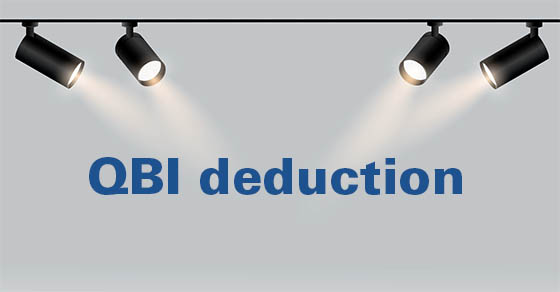
The qualified business income (QBI) deduction, which became effective in 2018, is a significant tax benefit for many business owners. It allows eligible taxpayers to deduct up to 20% of QBI, not to exceed 20% of taxable income. It can also be claimed for up to 20% of income from qualified real estate investment trust dividends.
With recent changes under the One, Big, Beautiful Bill Act (OBBBA), this powerful deduction is becoming more accessible and beneficial. Most important, the OBBBA makes the QBI deduction permanent. It had been scheduled to end on December 31, 2025.
A closer look
QBI is generally defined as the net amount of qualified income, gain, deduction and loss from a qualified U.S. trade or business. Taxpayers eligible for the deduction include sole proprietors and owners of pass-through entities, such as partnerships, S corporations and limited liability companies that are treated as sole proprietorships, partnerships or S corporations for tax purposes. C corporations aren’t eligible.
Additional limits on the deduction gradually phase in if 2025 taxable income exceeds the applicable threshold — $197,300 or $394,600 for married couples filing joint tax returns. The limits fully apply when 2025 taxable income exceeds $247,300 and $494,600, respectively.
For example, if a taxpayer’s income exceeds the applicable threshold, the deduction starts to become limited to:
- 50% of the amount of W-2 wages paid to employees by the qualified business during the tax year, or
- The sum of 25% of W-2 wages plus 2.5% of the cost (not reduced by depreciation taken) of qualified property, which is the depreciable tangible property (including real estate) owned by a qualified business as of year end and used by the business at any point during the tax year to produce QBI.
Also, if a taxpayer’s income exceeds the applicable threshold and the QBI is from a “specified service business,” the deduction will be reduced and eventually eliminated. Examples of specified service businesses are those involving investment-type services and most professional practices, including law, health, consulting, performing arts and athletics (but not engineering and architecture).
Even better next year
Under the OBBBA, beginning in 2026, the income ranges over which the wage/property and specified service business limits phase in will widen, potentially allowing larger deductions for some taxpayers. Instead of the distance from the bottom of the range (the threshold) to the top (the amount at which the limit fully applies) being $50,000, or, for joint filers, $100,000, it will be $75,000, or, for joint filers, $150,000. The threshold amounts will continue to be annually adjusted for inflation.
The OBBBA also provides a new minimum deduction of $400 for taxpayers who materially participate in an active trade or business if they have at least $1,000 of QBI from it. The minimum deduction will be annually adjusted for inflation after 2026.
Action steps
With the QBI changes, it may be time to revisit your tax strategies. Certain tax planning moves may increase or decrease your allowable QBI deduction. Contact us to develop strategies that maximize your benefits under the new law.
© 2025





